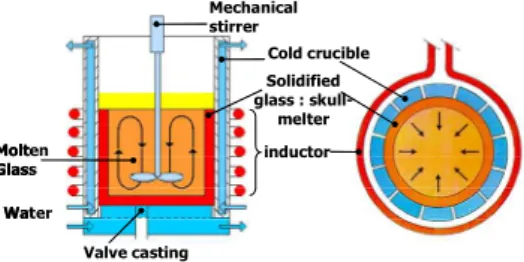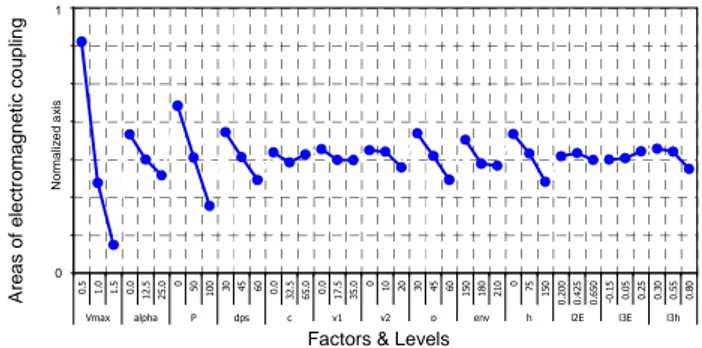HAL Id: hal-00520131
https://hal.archives-ouvertes.fr/hal-00520131
Submitted on 22 Sep 2010
HAL is a multi-disciplinary open access
archive for the deposit and dissemination of
sci-entific research documents, whether they are
pub-lished or not. The documents may come from
teaching and research institutions in France or
abroad, or from public or private research centers.
L’archive ouverte pluridisciplinaire HAL, est
destinée au dépôt et à la diffusion de documents
scientifiques de niveau recherche, publiés ou non,
émanant des établissements d’enseignement et de
recherche français ou étrangers, des laboratoires
publics ou privés.
Coupling electromagnectic and thermo-hydrodynamic
simulations to optimize a vitrification furnace heated by
direct induction
Julien Platas, P. Brun, E. Sauvage, J. Lacombe, Gilles Cauffet, J.M Dedulle
To cite this version:
Julien Platas, P. Brun, E. Sauvage, J. Lacombe, Gilles Cauffet, et al.. Coupling electromagnectic and
thermo-hydrodynamic simulations to optimize a vitrification furnace heated by direct induction. 11th
WORKSHOP ON OPTIMIZATION AND INVERSE PROBLEMS IN ELECTROMAGNETISM, Sep
2010, Sofia, Bulgaria. pp.53-54. �hal-00520131�
XI-th International Workshop on Optimization and Inverse Problems in Electromagnetism September 14 – 18, 2010, Sofia, Bulgaria
COUPLING ELECTROMAGNECTIC AND
THERMO-HYDRODYNAMIC SIMULATIONS TO OPTIMIZE A VITRIFICATION
FURNACE HEATED BY DIRECT INDUCTION
J. Platas
1*, P. Brun
1, E. Sauvage
1, J. Lacombe
1, G. Cauffet
2, JM. Dedulle
31CEA – Marcoule, SCDV/LDPV, BP 17171, 30200 Bagnols sur Cèze, France
2 G2ELAB, (CNRS, Grenoble INP, UJF), Université de Grenoble, BP 46, 38402 Saint-Martin d’Hères, France
3 Director of Industry Partnership, BP 257, Phelma, 38016 GRENOBLE Cedex 1, France
*Email : julien.platas@cea.fr
Abstract. This study deals with the optimization of a cold crucible melter where electric currents are
directly induced in a glass charge. A design of experiments is used to determine the factors of the crucible design which have an impact on the efficiency. Numerical tools are used to lead the experiments: a finite volume software, used to solve hydrodynamics and thermal equations, is coupled to a finite element software which computes the Maxwell equations.
Keywords: Coupling, Design of experiments, Optimization, Sensitivity analysis.
INTRODUCTION
A direct induction process using the cold crucible technology is presently developed by the French Atomic Energy Commission and AREVA NC for the treatment of high level activity nuclear waste. This process is characterized by currents directly induced inside the molten glass and by the cooling of all the crucible walls.
To further the electrical power into the glass charge, minimize the energy losses by Joule effect, and homogenize the temperature in the glass, the furnace design is optimized.
The high dependence of physical properties of glass with temperature requires a strong coupling study between electromagnetic, thermal, and hydrodynamic phenomena [1]. Moreover, due to intrusive elements in the crucible (thermocouples, mechanical stirrer…) that significantly perturb the Joule power distribution a three-dimensional model for the electromagnetism phenomena is necessary.
Water Molten Glass Mechanical stirrer Cold crucible Solidified glass : skull-melter Valve casting inductor Water Molten Glass Mechanical stirrer Cold crucible Solidified glass : skull-melter Valve casting inductor
Figure 1. Cold crucible device
COUPLING STRATEGY
An iterative coupling for simulation of the stirred molten glass is achieved by two dedicated software [2]. The commercial software Flux® is used to solve induction equations. Owing to the high value of the frequency, the quasi-steady approximation is made. The A-V formulation (magnetic vector potential and electric scalar potential) (1) gives best results in a material with high gradient of electrical conductivity σ. The induced current j is given by equation (2).
(1) 1 0 0 r v r r v v = ∇ + ∂ ∂ + ∧ ∇ ∧ ∇ V t A A σ µ (2) ∇ + ∂ ∂ − = = ⋅ ∇ V t A j j v r r r v σ ; 0
The thermo-hydrodynamic phenomena are computed by the software Fluent® which solves the Navier-Stokes
(3) and thermal (4) equations [3]. Due to the high viscosity of the glass, the flow is assumed to be laminar. The terms coupling the electromagnetic and thermo-hydrodynamic equations are the non linear electric conductivity of glass and the Joule power density Qth induced into the molten glass (5).
(3) ∇⋅uv=0 v (4)
( )
u u p(
T T)
g t uv v v v v v v 0 0 0 =−∇ +∇ − − ∇ ⋅ + ∂ ∂ τ ρ β ρ(5)
( )
( )
th p p Q T T C u t T C + ∇ ⋅ ∇ − = ∇ ⋅ + ∂ ∂ v v v v λ ρ0 (6) σ 2 2 j Qth= .With: ρ0: the density of the glass, U: the velocity, P: the modified pressure, Τ: the stress tensor, Β: the thermal
expansion, T: the temperature, g: the gravity, Cp: the specific heat capacity and λ: the thermal conductivity. OPTIMIZATION METHOD
The influence of geometric factors on the electromagnetic performances of the furnace is studied. In particular, we consider the inductor position, the thickness of the electrical insulator arranged on the structure of the furnace, and the number of metallic sectors which constitute the crucible. From a hydraulic point of view, we study the impact of the mechanical stirrer geometry which improves the thermal homogeneity of the glass.
The method chosen for this study is based on a design of the experiments. This method is useful to minimize the number of experiments. The results of the design of experiments allow us to determine the influence of each factor, and to predict the response of the system in some cases. This study shows the effects of thirteen different parameters, each of them with three levels. Finally, the system is determined by the Taguchi table [4] and described with 27 simulations.
The responses obtained from the experiments allow us to quantify the phenomena which we have to optimize, like areas of the electromagnetic coupling or those of the thermal homogeneity.
A mesh composed of 750 000 elements is used for the thermo-hydrodynamic simulations. To simulate the mechanical stirrer rotation, the “multiple reference frame” and the “sliding mesh” methods are combined. Concerning the electromagnetic simulations by Flux®, formulations reducing the mesh are used: non-conductive areas and inductor are mesh-free, and some metallic parts are meshed only on their surface due to their high conductivity.
RESULTS
Figure 2.View of magnetic field computed around the
crucible. Scale: [0; 3500] A/m
0.002 0.004 0.006 0.008 0.010 0.012 0.014 0.016 0 .5 1.0 1.5 0.0 1 2 .5 2 5 .0 0 50 1 0 0 30 45 60 0 .0 3 2 .5 6 5 .0 0.0 1 7 .5 3 5 .0 0 10 20 30 45 60 1 5 0 1 8 0 2 1 0 0 75 1 5 0 0 .2 0 0 0 .4 2 5 0 .6 5 0 -0 .1 5 0 .0 5 0 .2 5 0 .3 0 0 .5 5 0 .8 0
Vmax alpha P dps c γ1 γ2 p env h l2E l3E l3h
Facteurs & Modalités
V o lu m e d e f lu id e s ta g n a n t (m 3) A re a s o f e le c tr o m a g n e ti c c o u p lin g
Factors & Levels
1 0 N o rm a liz e d a xi s 0.002 0.004 0.006 0.008 0.010 0.012 0.014 0.016 0 .5 1.0 1.5 0.0 1 2 .5 2 5 .0 0 50 1 0 0 30 45 60 0 .0 3 2 .5 6 5 .0 0.0 1 7 .5 3 5 .0 0 10 20 30 45 60 1 5 0 1 8 0 2 1 0 0 75 1 5 0 0 .2 0 0 0 .4 2 5 0 .6 5 0 -0 .1 5 0 .0 5 0 .2 5 0 .3 0 0 .5 5 0 .8 0
Vmax alpha P dps c γ1 γ2 p env h l2E l3E l3h
Facteurs & Modalités
V o lu m e d e f lu id e s ta g n a n t (m 3) A re a s o f e le c tr o m a g n e ti c c o u p lin g
Factors & Levels
0.002 0.004 0.006 0.008 0.010 0.012 0.014 0.016 0 .5 1.0 1.5 0.0 1 2 .5 2 5 .0 0 50 1 0 0 30 45 60 0 .0 3 2 .5 6 5 .0 0.0 1 7 .5 3 5 .0 0 10 20 30 45 60 1 5 0 1 8 0 2 1 0 0 75 1 5 0 0 .2 0 0 0 .4 2 5 0 .6 5 0 -0 .1 5 0 .0 5 0 .2 5 0 .3 0 0 .5 5 0 .8 0
Vmax alpha P dps c γ1 γ2 p env h l2E l3E l3h
Facteurs & Modalités
V o lu m e d e f lu id e s ta g n a n t (m 3) A re a s o f e le c tr o m a g n e ti c c o u p lin g
Factors & Levels
1 0 N o rm a liz e d a xi s
Figure 3. Example of the influence of the factors on the areas of
electromagnetic coupling
The whole simulations and their results lead us to understand the physical phenomena, in particular the magnetic field distribution repartition in the furnace (figure 2), and to appreciate the impact of each geometric factors on the system (figure 3).
CONCLUSIONS
A sensitivity analysis through a design of experiments permits to determine the effect of each geometric factor on the electromagnetic and thermo-hydrodynamic behaviors and leads to the optimization of the furnace.
REFERENCES
[1] L. Jacoutot, P. Brun, Y. Fautrelle, A. Gagnoud and J. Lacombe, "Numerical modelling of mechanically stirred molten glass bath heated by direct induction", in EPM 2006. Proc. of the 5th International Symposium on Electromagnetic Processing of Materials, pp 507-512, Sendai, Japan, October 23-27, 2006.
[2] L. Jacoutot, E. Sauvage, Y. Fautrelle P. Brun, A. Gagnoud and J. Lacombe, "Strategy of coupling to model physical phenomena within molten glass bath heated by direct induction", Compel The International Journal for Computation and Mathematics in Electrical and Electronic Engineering, Vol. 27, no. 2, pp. 369-376, 2008.
[3] E. Sauvage, P. Brun, L. Jacoutot, A. Gagnoud, Y. Fautrelle, J. Lacombe, "Thermoconvective instabilities of molten glass heated by direct induction in a cold crucible", Proc. of the International Scientific Colloquium of Modelling for Electromagnetic Processing, pp 151-156, Hannover, October 27-29, 2008.
[4] Gen’ichi Taguchi, S. Konishi, "Orthogonal arrays and linear graphs: tools for quality engineering", American Supplier Institute, ISBN 094124301X, 9780941243018, 1987.

